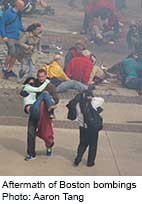
MONDAY, Aug. 19 (HealthDay News) — Prompt and liberal use of X-rays and CT scans is critical for assessing the injuries of blast victims, concludes a researcher who reviewed the medical response to the April 15 Boston Marathon bombing.
Doctors were able to save many people’s lives and limbs by using imaging scans to quickly assess injuries, said lead author Dr. Ali Guermazi, a professor of radiology at Boston University School of Medicine and one of the many specialists who treated bomb-blast victims at Boston Medical Center.
“When you have blast injuries, you need to liberally use imaging as quickly as possible, because that will show you multiple things,” Guermazi said. “It shows you shrapnel. It shows you soft tissue damage. It shows you the extent of damage to bone, and any fractures that have occurred.”
Three people died and 264 people were injured when two pressure-cooker bombs exploded one after the other near the marathon’s finish line. His report, published online Aug. 19 in Arthritis Care & Research, looks at how these critically harmed patients were managed and focuses largely on the use of radiological procedures.
Boston’s efficient and effective medical response to the bombings was aided by the proximity of multiple hospitals, Guermazi said.
“We coped really very well with what happened, with at least six world-class hospitals in the area,” he said. “If we only had one hospital, we would have been completely overwhelmed.”
However, many of the blast injuries were unlike anything that emergency room doctors had seen before, he noted.
“It was the first time I ever saw a bone that was missing from a leg, as if you took the bone, you cut it surgically and took it out,” Guermazi said. “It just went with the explosion, which also left a lot of shrapnel in the leg. It demonstrates how brutal a blast is and how the human body cannot cope with such an injury.”
Because of this, Guermazi recommends that doctors prepare themselves by studying the ways a bomb blast can damage the human body — by force of the blast wave, by flying shrapnel, by hurling the body through the air, and by exposure to chemicals or other toxins in the bomb.
“In an era of terrorism, even clinicians serving non-military patients need to understand the spectrum of injuries caused by bomb explosions,” he said. “Critically ill bomb-blast patients needed quick assessments of their injuries, which had the most devastating effects to the lower limbs.”
He also urged that hospital response plans emphasize the use of radiology to assess victims’ injuries.
“Blast injuries in the civilian environment are rare, but when they occur, the severity of injuries as well as the need to treat a large number of victims at the same time will be challenging,” Guermazi concluded in his report. “We suggest that in these urgent situations, radiology resources should be used liberally and promptly to allow swift assessment and patient management including life- and limb-saving treatment.”
Guermazi said he was on hand when the first reports of the Boston Marathon bombing came in, but he initially was skeptical that the explosions were intentional. Those doubts dissolved when he saw the first imaging scan of a limb riddled by shrapnel.
“As soon as I saw it, I just put my hands on my head,” he said. “I could see it was a terror attack because I could see all of the shrapnel.”
The article’s call for preparation is both smart and essential, said Dr. Sudip Bose, an emergency physician who handled the aftermath of hundreds of bombings as a U.S. Army doctor attached to an infantry unit in Iraq.
“I understand his concern and I think we need to be prepared,” Bose said. “It’s good that we think about the possibility of these injuries on our turf, because unfortunately it may happen again. But if it does happen again, I think with preparation we will be able to take care of this.”
However, Bose added that emergency physicians may not be able to wait for imaging studies if a patient’s wounds are dire.
“The number one priority is stopping bleeding, period,” he said. “If you look at the Korean War, if a soldier had an amputation it was pretty much a death sentence. But now we’ve pretty much eliminated extremity injury as a cause of death. You have to focus first on the basics of trauma — airway, bleeding and circulation.”
More information
For more information on blast injuries, visit the American Trauma Society.
Copyright © 2025 HealthDay. All rights reserved.

